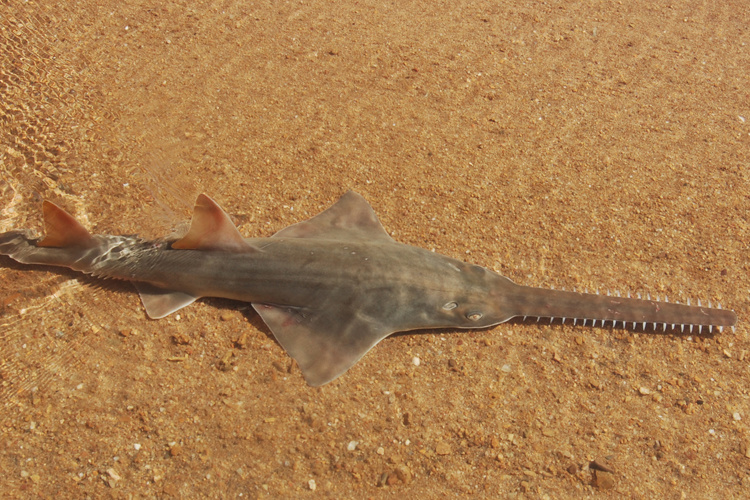By Raquel Gilliland; Sea of Change Intern
Our “Creature Feature” is back again for another week of education and conservation surrounding another mysterious sea creature! This week’s animal has the word “fish” in its’ name, but some people say it looks more like a shark; however, this week’s creature is actually a ray! Our confusing creature of the week is the famous sawfish, or carpenter sharks. There are five species of sawfish, the Queensland sawfish (Pristis clavata), the smalltooth sawfish (Pristis pectinate), the common/largetooth sawfish (Pristis pristis), the narrow sawfish (Anoxypristis cuspidate) and the narrowsnout/green sawfish (Pristis zijsron).

Easily identified by their long flattened nose, or rostrum, they were once abundant throughout the Atlantic Ocean the Indo-Pacific Ocean. Their current conservation status has taken a drastic turn in the past few decades due to habitat loss, bycatch, and overfishing; all five species are now listed as either endangered or critically endangered on the IUNC Red List of Threatened Species. Their long rostrums were prized not just in the recreational fishing community, but also in many ancient cultures and mythology. In what is currently Mexico, the ancient Aztecs depicted the rostrum being used as a weapon/sword and sawfish teeth have been found in Mayan graves. In Panama, sawfish were thought of as powerful spirits that could offer protection against supernatural enemies. They were even used as a modern symbol in WWII on navy ships and submarines.
Although they were once revered, these special rays are facing many challenges to their survival. Sawfish fins are among the most prized and expensive exports for shark fin soup, which is considered a delicacy in many Asian countries, yet adds no taste or health benefits. As with many other sharks and rays, sawfish parts are often advertised as traditional Chinese medicine, but no medical benefits have ever actually been proven. Their teeth are sold and used for cockfighting spurs in Peru and Ecuador. And sadly their rostrums are sold as a novelty item to tourists in many countries.
What’s happening to save these creatures? In 2007, all five species were listed on CITES Appendix I, which prohibited the harvest and trade of all sawfish and their parts. Unfortunately, people are still illegally catching and selling sawfish all over the world, it is easy to identify their rostrums, but difficult to identify their fins in the fish markets.
One of the largest sawfish conservation projects is currently happening in Florida at the Florida Museum of Natural History, which maintains the International Sawfish Encounter Database where people can submit information about a sawfish encounter or sighting, whether it’s alive or a rostrum hung on a wall. Next time you encounter a sawfish get online and let them know! Also get to know your favorite shark/ray conservation team and get involved in any way that you can with donating, becoming involved in local campaigns, and making sustainable lifestyle choices!




